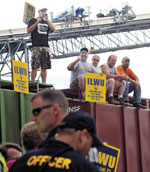
Showdown on West Coast Docks: The Battle of Longview
(November 2011).
click on photo for article
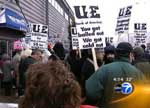
Chicago Plant Occupation Electrifies Labor
(December 2008).
click on photo for article
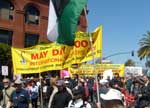
May Day Strike Against the War Shuts Down
U.S. West Coast Ports
(May 2008)
click on photo for article

May 2020
For Free, Safe Subways and Buses!
MTA Bosses’ Coronavirus
Disaster:
For Workers Control of NYC
Transit!
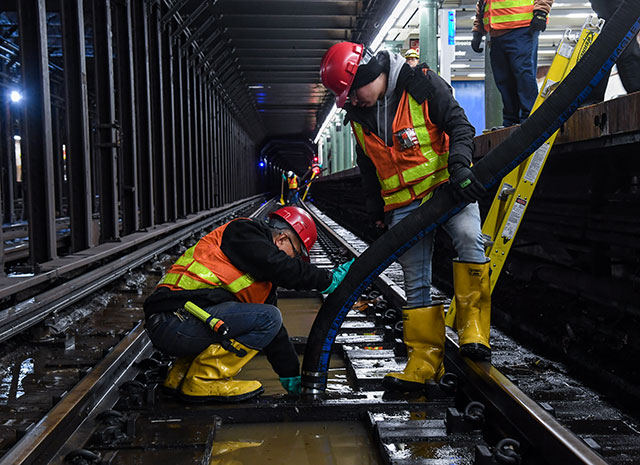
New York City transit workers draining flooded station to restore service after water main break, January 13. (Photo: Marc Hermann / NYCTA)
Public recognition and praise have been showered on the health care workers who are in the front lines in fighting the coronavirus pandemic, and rightly so. They have heroically been working grueling 12-hour shifts, day after day, forced to reuse single-use respirators and even don trash bags as protection, desperately trying to save thousands of patients with COVID-19 (the disease caused by the virus), for which there is as yet no proven treatment. It’s not just the nurses, doctors, physician assistants and emergency medical technicians, but also the thousands of non-medical personnel who make the hospitals run, who are supplied with even less protective gear and whose rate of falling ill and dying of the disease may be even higher.
Right up at the top of the list of unsung heroes of the pandemic are New York City transit workers, at least 120 of whom have died of COVID-19, as of May 11.1 Altogether over 3,000 employees of the Metropolitan Transportation Authority (MTA) tested positive for the virus while 9,000 had been or were still under quarantine as of April 21. Early on, the New York Daily News headlined, “MTA workers dying from coronavirus at triple the rate of agencies that employ NYC first responders.” Transit workers are disproportionately falling victim to the disease because many are in close contact with large numbers of people, and because of perilous work conditions fostering lung disease, but also because of criminal actions of the MTA.
The 40,000 members of Transport Workers Union (TWU) Local 100, along with the almost 5,000 members of Amalgamated Transit Union (ATU) Locals 1056, 1179 and 726, are the beating heart of New York. They keep the city moving – without their labor NYC would freeze up, as we saw in the 2005 transit strike. Today, despite the palpable danger, they have kept the mass transit system going through the pandemic. They have indeed been essential in taking health care workers,grocery/bodega workers, utility workers and others to their vital jobs. Yet they have been treated as disposable workers by the capitalist class and by their arrogant MTA managers, who flat-out refused to give them personal protective equipment (PPE) when the unions asked for it.
Transit Workers Across U.S. in Grave Danger – Fight for Health and Safety Now!
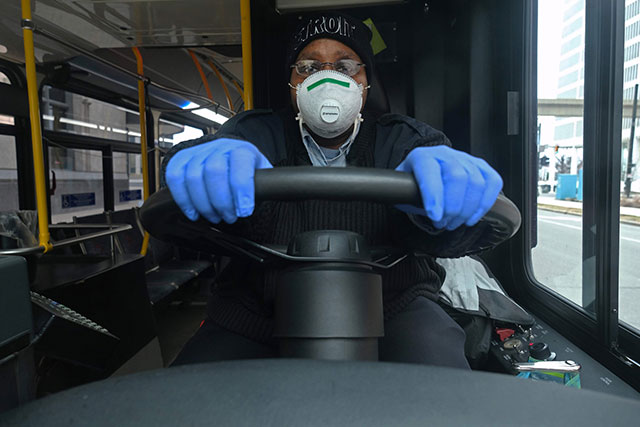
Detroit bus driver wearing N95 mask, March 2020. Drivers walked out to demand personal protective equipment, cleaning buses and bathroom facilities. In 24 hours city agreed to their demands. (Photo: Seth Herald / AFP)
The dangerous conditions facing subway and bus workers are not limited to New York. Public transportation workers in other major cities are also dying at a higher rate, in part due to inadequate safety measures by management. Under pressure from the ranks, the leaders of the TWU and ATU, who together represent over 330,000 workers nationwide, issued a joint statement (April 3) declaring, “If transit agencies don’t take immediate and dramatic steps to protect our members, there will be serious consequences,” and vowing to “take aggressive action.” That was over a month ago. Since then, transit workers keep dying. So where are the “serious consequences” and “aggressive action”?
Instead, what union action there has been has come from the ranks. On March 17, Detroit bus workers walked out, spurred by the statewide shutdown of restaurants which left drivers with no bathroom facilities and places to wash up. They also complained of passengers coughing and sneezing as they put money in fare boxes. The union (ATU Local 26) backed them up, demanding PPE, daily cleaning of buses and other sanitizing measures. The city canceled bus service, citing “driver shortage.” Within 24 hours, the mayor agreed to quadruple cleaning crews, supply gloves and masks (when available!), provide portable restrooms (hardly sanitary) and waive fares so passengers would board to the rear of the bus, well back from the driver.
Yet a month and a half later, the Detroit city council passed a budget with several hundred layoffs and $200 million in program and service cuts, including a $20 million cut to its contribution to the bus system (Crain’s Detroit, 5 May). This is a foretaste of the billions that will be slashed from government budgets around the U.S., as the coronavirus depression has already begun. The predictable result will be a drastic deterioration of public transit, along with schools and other vital social services, at a time when a vast expansion is necessary. That makes it all the more urgent that transit workers take bold action now. If they don’t, the bosses will sock it to all working people. The class struggle doesn’t take a time-out in a pandemic.
Even though Detroit bus workers won some demands, this did not ensure their safety. A few days after the walkout, driver Jason Hargrove posted a video complaining that a woman had not covered her mouth while repeatedly coughing when she was on his bus. Four days later, he fell ill with COVID-19, and he died on April 1. Local union president Glenn Tolbert told CNN (3 April), “We see more sick people than any doctor…. We pick up the sick taking them to the hospitals.” As an article in CityLab (13 April) noted, citing U.S. Bureau of Labor Statistics data: “Even under normal conditions, city bus drivers have one of the highest rates of injuries and illnesses of all occupations, between vehicle crashes, belligerent passengers, and the grind of physical labor.”
In Los Angeles, while ridership has fallen by 65%, the number of Metro buses has been cut back so far that some lines are even more crowded – forget “social distancing.” Due to drivers’ insistence, passengers are boarding by the back door, but the Metropolitan Transit Authority is still telling them to pay fares up front. (Many drivers have simply cordoned off the front with bungee cord and seatbelts.) Metro management says it “ordered more than 1 million protective items” but delivery could be a month off and many are in short supply now (Los Angeles Times, 4 May). Union leaders complain that “It’s like pulling teeth to get our supplies,” as Art Aguilar, president of ATU Local 1277 told the Times. But they have not called any action.
An April 11 leaflet by Joseph Wagner, a union militant in Local 1277 who organized contingents of Transport Workers Against Deportations, called to “use our power to demand adequate health and safety measures, as part of defending all the working class and oppressed people in the midst of this crisis.” He pointed to the fact that bus drivers, who are among those most exposed, were fourth out of six categories to receive PPE. The leaflet called to “elect UNION SAFETY COMMITTEES” encompassing all three MTA workers unions, to “enforce safe work conditions” and “demand the PPE, cleaning supplies and procedures deemed necessary by the workers themselves.” Compliance should be assured by “using the workers’ power.” As for the fare box, Wagner declared:
“We need to demand FREE PUBLIC TRANSIT! Expand the frequency and hours of service. Take out the turnstiles. Cops and I.C.E. agents out of the transit system and off the platforms…. UNION POWER, WORKERS POWER. It’s a matter of life and death.”
–Leaflet reprinted in The Internationalist No. 59. March-April 2020
NYC Transit Bosses’ Policies Cost Transit Workers’ Lives
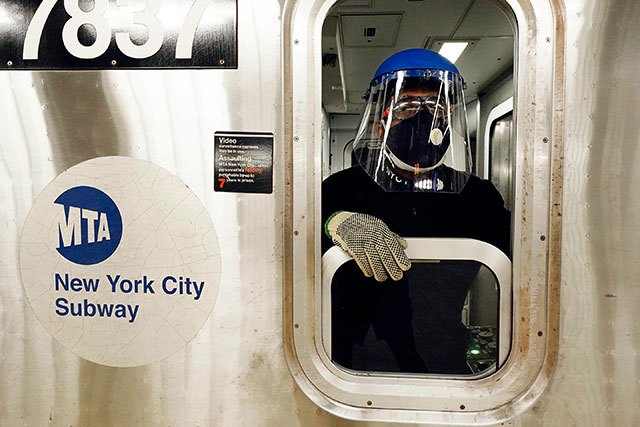
NYC subway conductor with full face shield, which MTA only started distributing in mid-April. Transit bosses’ refusal to hand over PPE, turning down union leaders’ requests and even disciplining employees who violated rule, cost transit workers lives. (Photo: Fortune magazine)
Last December, the leadership of TWU Local 100 in New York City negotiated a contract – then extended to the ATU – with wage “increases” that at best barely keep up with inflation, while it increased copays for hospitalization and prescriptions, and left concerns about workplace safety totally ignored (see “Transit Workers Screwed by No-Gain Contract,” Internationalist No. 58, Winter 2020). The ratification vote was barely in when a new threat appeared on the horizon, the explosion of the coronavirus epidemic (now pandemic). On January 28, Local 100 President Tony Utano met with MTA tops to discuss coronavirus safety measures for transit workers (New York Times, 8 April). Once again, he got bupkis, zero, nada.
By the time TWU and agency bosses met again, the virus was already spreading in New York. According to the Times:
“Workers had already started requesting protective gear, like masks and gloves, but their appeals were denied…. At the March 5 meeting, Mr. Utano and other labor leaders pressed the M.T.A. to alleviate the panic spreading among employees by providing masks to all workers and suspending the use of an attendance system that required them to touch a shared screen.”
The response was a March 6 memo from MTA chief security officer Patrick Warren literally banning workers from using masks, saying that as they are “not part of the authorized uniform, they should not be worn by employees during work hours.” If a worker did anyway, supervisors were instructed that “they should tell the employee that masks may not be worn by employees during work hours.” On March 17, the TWU demanded coronavirus testing for all workers. Days later, workers started a petition for hazard pay. The MTA’s response: no, no, no.
As if to add insult to injury, the MTA had in place an influenza pandemic plan under which the agency was to maintain a six-week supply of PPE with the express purpose of distributing it to transit workers. According to the 2012 plan, excerpts of which were published on the website of Progressive Action, an opposition group in Local 100:
“In order to ensure that general Pandemic materials are available to address a Pandemic Influenza wave, a 6 week supply, or as directed by the PC/CMT, of the following materials will be stockpiled including: 1) Hand Sanitizer Wipes…. 2) Hand Sanitizer Gel…. 3) Surface Wipes…. 4) Disposable Gloves…. 5) N-95 Respirators….”
–“New York City Transit Policy Instruction” (31 December 2012)
Moreover, the MTA literally had pallets of N95s sitting around which they refused to hand out to workers. At two Brooklyn bus depots, where according to internal documents obtained by The City (23 March) the agency had 4,500 N95 respirators in stock, management even put up signs warning operators that “face masks are not to be issued to you.”2
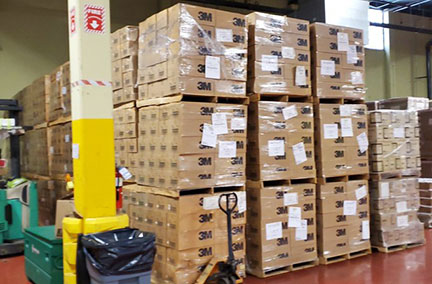 MTA had pallets of N95 masks
that it refused to distribute to transit workers, March
14. (Photo: Progressive
Action)
MTA had pallets of N95 masks
that it refused to distribute to transit workers, March
14. (Photo: Progressive
Action)Only on March 27 did the MTA relent on its outright ban on masks. By then eight transit workers had died of COVID-19 and thousands were out sick. The agency subsequently said it has distributed 2.7 million pairs of gloves and “750,000 masks, which includes about 300,000 N95s” since March 1 (Staten Island Advance, 13 April). It vowed to distribute 75,000 masks to workers every week and said it had begun issuing face shields to subway conductors. (What about bus drivers?) Yet a week after the MTA’s policy change, workers complained that they still had not been issued PPE. In fact, the union took matters into its own hands by distributing masks itself – 50,000 of them, according to TWU International President John Samuelsen.
To justify its policy of refusing to hand out PPE to workers for weeks as the virus spread, MTA chief Pat Foye hid behind the policies of the Centers for Disease Control and Prevention (CDC) and World Health Organization (W.H.O.) which said that medical masks should be reserved for healthcare workers.3 But those were advisory notices to the general public, not some kind of prohibition or mandatory requirement aimed transit workers taking into account their specific working conditions. Among those conditions are spitting attacks on bus operators (and also train conductors), which would be particularly dangerous in the coronavirus outbreak. Since 2018, incidents of spitting on bus drivers have reportedly increased by 35% (Mass Transit, 21 February).
There are other significant factors contributing to the alarmingly high death rate among NYC transit workers which have been largely ignored. Among the most deadly are the effects of special oppression by race and ethnicity, as data for New York show that African Americans are twice as likely to die of COVID-19 as whites, and Latinos one and a half times. Almost 70% of frontline MTA employees are black or Hispanic. Another factor is age, since four out of five of those who have died of COVID-19 are age 65 or older. Nationwide, 13% of transit workers are in that age bracket, compared to 7% of the working population in general. Of the NYC transit workers who have died of the disease and whose age is known, well over two-thirds (69%) were age 55 and older.
By far the most important factor making the coronavirus more deadly is preexisting medical conditions. Transit workers have extremely high rates of lung disease. TWU chief Samuelsen noted the diesel fumes bus operators breathe in every day, the steel dust subway workers absorb, the manganese from welding, the creosote used to soak railroad ties to preserve them. “These are carcinogens and they directly affect the lungs, and this is why so many transit workers die of lung disorders. And COVID-19 attacks the lungs,” he noted (The Chief-Leader, 16 April). A transit worker added that maintainers in electrical, track and structure divisions also face asbestos, mold and much more in confined spaces.
The evidence points to the occupational hazards transit workers face year-in and year-out as the main factor behind the huge number of MTA employee deaths. Of the 120 who have died, 24 were bus operators, while 33 were track workers, signal maintainers, car inspectors and others from sectors that have little contact with the public but spend their working hours in the tunnels and the shops. This could also be behind the additional large number (40) of retiree deaths from COVID-19. That raises the question of whether these workers should have had breathing devices well before the coronavirus hit, and as Samuelsen noted, it illustrates “why transit workers should be able to retire at 50” as they used to be able to do. Instead legislators have repeatedly tried to raise the retirement age above the current 55 (with 25 years on the job).
Yet after listing the many factors that have contributed to the high death toll of bus and subway workers, speaking with Politico (22 April) Samuelsen outrageously “praised the MTA for being ahead of other systems” in dealing with the coronavirus. What a travesty! The fact is that Samuelsen and Local 100 president Utano have politically chained the TWU to Democratic governor Cuomo, and to his appointees, the MTA bosses. With its policy of collaboration with the bosses, the union bureaucracy sold the membership out in contract negotiations, and now it has done it again by failing to act to force the MTA to respect the basic health and safety of the members, and hand over the PPE they were demanding.
MTA Bosses Use Cops to Apply “Shock Therapy” to Mass Transit
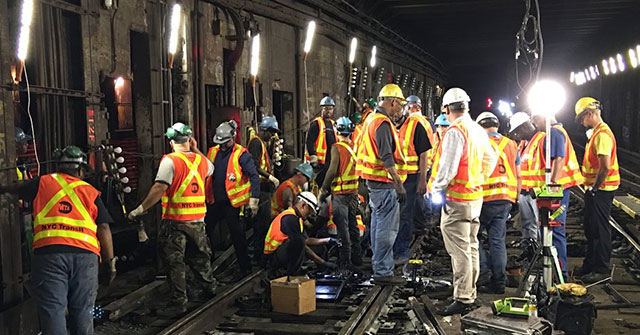
Transit workers repairing 125th Street Station the day after June 2017 derailment. Transit workers led passengers to safety. MTA bosses want to eliminate all conductors and drivers, a threat to all who work in and ride subways. (Photo: Transport Workers Union Local 100)
For decades, Democratic and Republican governors and mayors and their appointees on the MTA board have run down the New York City transit system. During the post-Vietnam War crisis triggered by Wall Street banks, agencies were set up (the Metropolitan Assistance Corporation and Emergency Financial Control Board) to sharply cut personnel, lower wages and “defer” basic maintenance – as they did with all city services, from bridges and tunnels to education. After the 2007-09 financial crisis, the MTA resorted to multiple fare increases and service reductions. As city and state finances improved, Cuomo favored glitzy projects like the Second Avenue line on the upscale Upper East Side and the Fulton Center near Wall Street over basics like replacing decrepit signals.
As subway ridership doubled since 1992 while maintenance expenditure dipped, on-time performance plummeted to 65%, the worst of any major transit system in the world. It resulted in the 2017 NYC transit crisis, with a series of derailments, track fires and chronic overcrowding due to train delays. Governors and mayors had stripped $1.5 billion from the system, diverting tax revenues earmarked for the subways to pay for juicy investment and I.T. contracts (and bailing out ski resorts). It was financed with exorbitant loans saddling the MTA with $5 billion in interest, so that “Nearly 17 percent of its budget now goes to pay down debt – roughly triple what it paid in 1997” (“The Making of a Meltdown,” New York Times, 18 November 2017).4
Today, the NYC transit system is in the worst crisis in its history, as subway ridership plummeted by nearly 92% and buses by 97%, as of April 2. Naturally, the MTA is crying poverty, estimating that it could lose anywhere from $5.6 billion to $7.4 billion in revenue this year as a result of the COVID-19 shutdowns. While admitting that it currently has $3.5 billion in “liquidity resources” and expects to receive $4 billion from the CARES Act, the agency warns of “a significant gap in funding for both its operating budget and capital plan over the long term” which “will likely result in additional debt issuance and unfunded operating needs.”5 The NY State budget just increased the MTA’s bond cap from $55.5 billion to a whopping $90 billion.
So more debt, for sure. And who do you think will pay off the debt, and those “unfunded operating needs”? The working people, of course, as always. The MTA is the only mass transit system in the U.S. where a majority of the revenue (56%) comes from fares and tolls. (In Portland, Oregon, 77% of TriMet’s income comes from taxes, as does 90% of L.A. County Metro’s revenue.) So in New York City the result will be more service cuts and fare increases, reducing the number of riders and pushing poor people out of the system. This is the intended effect, which will now be justified in the name of “social distancing,” to be enforced by an army of police riding the trains and infesting the stations.
Presiding over it all in NYC is the Metropolitan Transportation Agency that runs the mass transit system on behalf of the capitalist rulers. The MTA bosses will do whatever it takes to pay off “investors.” Wall Streeters, of course, love debt. For those who don’t make billions from stock market and real estate speculation, or mergers and acquisitions, the preparing, marketing and collecting of money from bonds and loans is their life blood. In times of economic crisis, bankers look to “public” entities with a steady cash flow. A Donald Trump (the self-styled “King of Debt”) can default, as he often did; so can municipal bonds relying on tax revenue. But the MTA has fares and tolls squeezed from working people in good times and bad. While its bonds have been downgraded by the ratings agencies, with $45 billion in outstanding debt and more to come, the bottom line is, as the research firm Municipal Market Analytics wrote: “The MTA is too important to the New York State and U.S. economies for the state to let fail”.6
So who manages the MTA? Chairman and CEO Pat Foye is a lawyer installed by Andrew Cuomo last year and rubber-stamped by the state Senate in the dead of night. He moved to the transit agency after doing the guv a favor as head of the NY-NJ Port Authority by foiling New Jersey governor Chris Christie in the 2013 “Bridgegate” scandal. At the MTA, Foye pushed for outsourcing station and car cleaning to non-union contractors while going after transit workers for sick days and overtime. In the current coronavirus crisis, Foye’s signal contribution was to declare that “the subways remain safe,” while in the next breath telling people not to use them to avoid getting sick (New York Post, 9 March). Meanwhile, transit workers were becoming infected by the thousands.
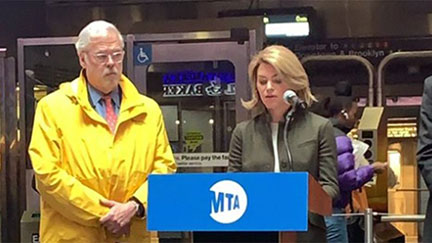 MTA
chairman Pat Foye and NYCTA interim president Sarah
Feinberg, 25 February 2020.
(Photo: Fox5)
MTA
chairman Pat Foye and NYCTA interim president Sarah
Feinberg, 25 February 2020.
(Photo: Fox5)The acting president of the New York City Transit Authority (NYCTA), which runs the buses and subways, is Sarah Feinberg, appointed by Cuomo on March 6 to replace Andy Byford, who quit over friction with the governor. In the 1990s Feinberg was communications director for the House Democratic Caucus. In 2008-09, she studied Middle East policy at the National Defense University at Fort McNair in Washington. In 2009-10, she was the senior advisor to White House chief of staff Rahm (“Never Let a Good Crisis Go to Waste”) Emanuel and a special assistant to President Obama. She then moved to the private sector, as global communications director for Bloomberg LP, and later “director of policy and crisis communications” at Facebook. Then it was back to Washington as head of the Federal Railroad Administration.
In a word, Feinberg is well-connected: part of the Democratic Party capitalist nomenklatura that moves from one agency and business to another, bouncing between D.C. and NYC. As Transit Committee chair for the MTA, she was the architect of last year’s offensive to flood the system with 500 MTA police, supposedly to fight a (non-existent) crime wave but in fact to go after “fare beaters.”7 Now, as NYCTA chief, Feinberg has unleashed 1,000 cops to go after homeless people. In an op-ed in the New York Post (27 April), she wrote that the MTA was changing its rules “to make it abundantly clear that the transit system must be used by people for transport only…. We will enforce these new regulations in close coordination with our NYPD partners and the MTAPD.”
As Cuomo “reimagines” (guts) public education with “virtual learning,” steered by Microsoft founder Bill Gates, and “reimagines” the New York State economy with a commission headed by former Google CEO Eric Schmidt, influential sectors of the bourgeoisie plan to apply “shock therapy” to the New York City subways, beginning with shutting down late-night service.8 They want to lure well-to-do petty-bourgeois back from the suburbs to the city centers. Meanwhile, they want to make subways more efficient in bringing workers from the far reaches of the Outer Boroughs, where they have increasingly been pushed by skyrocketing rents, into Manhattan jobs. And they want to cut the MTA’s wage bill by doing it with fewer workers: read speed-up and layoffs.
As could be expected, MTA bosses blame the poor and homeless for bringing disease into the transit system, throwing them off the trains onto the street or into the virus-impacted shelters. In point of fact, the first recorded infection in metropolitan NYC was of a Westchester lawyer who took an MTA train to Midtown Manhattan. Now they will point to the mask requirement to make riders feel they are safer on the subway, where “social distancing” at six-foot intervals is utterly impossible. Yet coronavirus hotspots still ricochet around the city (first Corona/Elmhurst, then the Bronx, now middle-class areas of Staten Island and outer Queens). For all the talk of “flattening the curve,” the number of infections will likely not be lessened, only spread out over time so they don’t overload the hospitals.
For Workers Control of NYC Transit, Now!
The MTA managers, and their bosses in the State House and City Hall, have amply proven over the years that they are incapable of producing a safe, efficient, clean and comfortable mass transit system – and certainly not one that would be in the interests of the workers who run it and the poor and working people who use it. From the “deferred maintenance” of the 1970s to the subway crashes and ever-worsening performance of the 2010s, they have focused on paying off Wall Street, while riders have to put up with crumbling infrastructure and overcrowded, perennially late and frequently delayed trains. The only way to clean up the subway mess is for the workers to take charge.
Transit workers know best how to make the system work. The professional managers who jump from one agency, authority or administration to another, who exist to serve the Wall Street speculators and real estate sharks, and whose kneejerk response to any problem is to bring in the police, do not. They can only lead to a train wreck – sometimes literally, as Feinberg had a string of during her stint as railroads chief. In fact, when the coronavirus crisis hit, the workers took the initiative to keep the system functioning. They demanded protective gear when the MTA managers refused to give out stocks of PPE they had in hand for such an emergency. The union tops contented themselves with press statements and “behind-the-scenes” maneuvering instead of taking bold action to get what was needed.
Bus drivers began cordoning off the front of their buses with chains and implementing back-door boarding, effectively making transit on local buses free – a show of solidarity with NYC’s working people. The MTA had no choice but to endorse the policy after the fact on March 20. In a letter to the (acting) president of MTA Buses, a driver and Local 100 shop steward, Michael Enriquez, called to modify schedules so that “Bus Operators take their prescribed breaks at their respective depot” to “ensure that each bus placed into service is disinfected regularly throughout the day,” instead of the MTA’s every three days. It was clear, Enriquez told the Times (8 April), that “if any changes are going to be made, we are going to have to be the ones to facilitate it.”
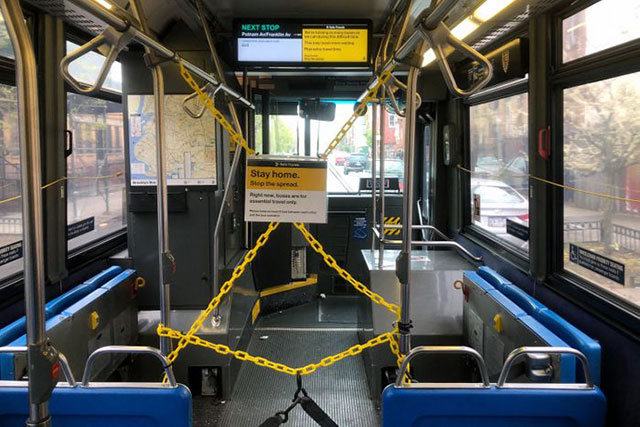
Drivers chained off front of the bus to limit contact with passengers who board through the rear door, effectively making buses free. We say: make no-fare travel permanent and extend to the subways. (Photo: The City)
Enriquez’ letter pointed out the need to install barriers between drivers and riders “to serve as sneeze guards,” recommending “a minimum 6-mil plastic sheeting or plexiglass” to replace the “presently installed chains.” He lambasted the MTA for failing to inform workers who had come into contact with another employee who had tested positive. Other union officials said they tried to get management to send individual workers home who had known medical conditions that would put them at greater risk, but to no avail. Instead supervisors were instructed to write up any employee who used a mask, continuing the vicious “plantation justice” of the MTA which hands out thousands of disciplines every year for the slightest infraction.
As an 18 March call to action by Class Struggle Workers – Portland stated, in a crucial appeal to unions and all workers, we must demand that:
“All workers who continue to work shall be furnished with all Personal Protective Equipment (PPE) necessary, as determined by the workers themselves…. Unions should also take the lead in forming health and safety committees, to be elected at every workplace, both union and unrepresented, to ensure that all safety measures are being enforced for all workers, and that all necessary equipment is available…. No work should be performed until these basic safety practices are in place.”
Such measures challenging the “right” of the bosses to manage the workplace are today a matter of life and death. They are also the beginnings of workers control. The issue is who decides on the shop floor, in the bus barns, on the road and on the tracks. MTA management has had their way, for decades, and over 100 workers are dead, in no small degree because of the criminal policies imposed by the MTA bosses, the Foyes and Steinbergs – and also by “train daddy” Byford – at the behest of their boss Cuomo, all of them driven by the dictates of capital. They have got to go, and so does the brutal capitalist profit system that they serve.
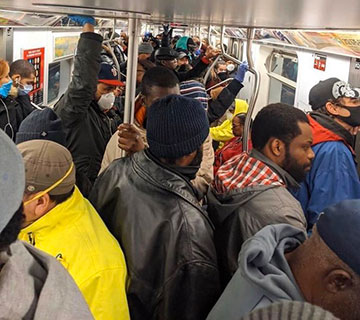 Rush hour, April 2: Amid the
pandemic hundreds of thousands of workers, mostly
low-wage, African American, Latino and immigrant, go to
work performing vital tasks, yet MTA service cutbacks
still produce crowded trains. (Photo: Twitter)
Rush hour, April 2: Amid the
pandemic hundreds of thousands of workers, mostly
low-wage, African American, Latino and immigrant, go to
work performing vital tasks, yet MTA service cutbacks
still produce crowded trains. (Photo: Twitter)Some union members, reflecting a justified, total mistrust of the MTA, have called to simply shut the system down. Some say for two weeks – but what will change in two weeks if the same people are in charge? Workers should absolutely use their power to shut down operations to ensure safeguards are met, as the Detroit bus drivers did in their March 18 walkout. At the same time, keeping the NYC buses and subways running amid the pandemic is essential, not only to ensure that healthcare workers can get to and from work, but also for the hundreds of thousands of workers – mostly low-wage, African American, Latino and immigrant – who have no choice but to go to work, and whose labor is vital to supplying a population confined to their homes.
In an op-ed article in the New York Times (6 May), MTA conductor Sujatha Gidla9 wrote:
“The conditions created by the pandemic drive home the fact that we essential workers – workers in general – are the ones who keep the social order from sinking into chaos. Yet we are treated with the utmost disrespect, as though we’re expendable…. My co-workers say bitterly: ‘We are not essential. We are sacrificial’.”
In normal times, the ruling class only discovers that transit workers are “essential” in a strike, when it wants to keep trains running, which strikers must stop in order to win their vital demands. But the fact that bus and subway workers are essential gives them great power, to decide what is needed and then to enforce that against the bosses who over the years have made the transit system into a death trap for those who toil in it. But that power is only potential: you have to use it, or lose it. The bosses know that, which is why they are moving fast to exploit this crisis. Transit workers should say: We make New York run, we can shut it down, we decide what goes – and the MTA can go to hell!
With subway workers calling the shots, they would decide what PPE is necessary. They could demand full face shields for all drivers, conductors and bus operators. They would order the installation of track safety technology, which could be easily done today, to ensure that no more track workers die on the job.10 They would decide on what breathing and ventilation equipment is necessary for working in the tunnels, the garages and the shops. For the buses, workers should insist that they be retrofitted to make a full driver’s cabin that could provide real protection. There should be a union hiring hall. For passengers, reduce overcrowding by running more trains. And the present temporary no-fare system on buses should be made permanent and extended to the subway. For free, quality mass transit!
These are emergency measures, and if ever there was a transit emergency, this is it. Workers safety committees, with no management presence, should be formed to determine what are safe working conditions and to take immediate measures to ensure that all units are in compliance. That requires a very different kind of union leadership than what is practiced by the TWU/ATU tops. The pro-capitalist bureaucracy is wedded to the policy of class collaboration. It goes along with MTA bosses even as their policies are killing workers. It allies with bourgeois politicians like Andrew Cuomo, who appoints the agency administrators. A class-struggle leadership is needed to oust the sellout bureaucrats, break with the Democrats and all capitalist parties, and help give a lead to the vital task of building a revolutionary workers party.
Enough is enough! Transit workers urgently need to take matters into their own hands and implement workers control of mass transit with elected workers committees at every yard, depot, shop and station. These committees should immediately undertake the work of organizing transit service for the benefit of NYC’s working people. That means ripping out the turnstiles and fareboxes to make public transit free. It also means ousting cops and security guards from the unions and from the subways. The police are labor enforcers for the bosses, against the workers and oppressed, and are using this pandemic as an excuse to ramp up racist repression on the subways.11
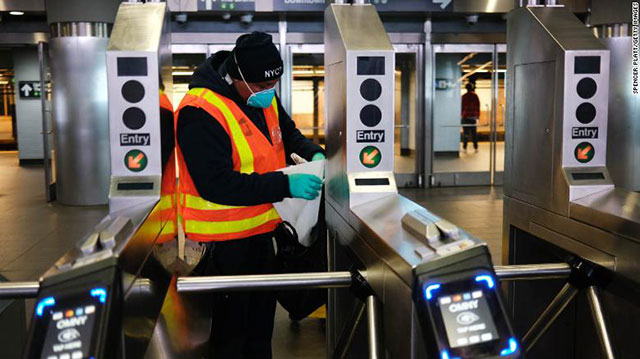
Cleaning turnstiles on NYC subway, May 6. We say: rip out the turnstiles to make public transit free. (Photo: CNN)
Workers control is “dual power” in the workplace, as workers assert their power against the bosses. It cannot last for a lengthy time, or else the committees will get sucked in to “co-managing” with the capitalists. To be successful, it must be a step on the road to a workers government. As we wrote in a recent article about workers fighting for their health and safety across the U.S. during this pandemic:
“What’s desperately needed is a labor movement built upon the old principles of class against class, of the working class mobilizing its social power, as the ‘essential’ producers of wealth who make society function. And that means a class-struggle union movement that combats all forms of social oppression, that places itself in the forefront of the struggle against racism, the fight for full equality of women, gays, lesbians and transgender people, and that joins these struggles in a fight to do away with the capitalist system that produces death and destruction for everyone. It means a fight for revolutionary leadership.
– “As the COVID-19 Pandemic Rages, Workers Fight for Health and Safety,” The Internationalist No. 59, March-April 2020.
So long as capital rules and production is for profit, one way or another working people will get screwed. It will take a socialist revolution that expropriates the capitalist class to organize the economy through a rational plan, including a campaign to contain the pandemic, develop medicines to treat it and discover a vaccine to combat it, instead of today’s deadly chaos brought to us by the profit system.
Brothers and sisters of Local 100, now is the time to act. Take control of the transit system and put it to work for the benefit of all NYC’s working people! In this time of great fear and trepidation, your example would be a beacon in the night for millions of workers, including millions of undocumented immigrant workers, who can be spurred to action by your lead. ■
- 1. The figures are from the Facebook page of bus operator Danny Cruz, which has meticulously kept track of the terrible death toll of coworkers. See https://www.facebook.com/dclovesvc437/posts/3540674225959434.
- 2. Unlike surgical and cloth masks now required for passengers on all NYC subways and buses, which provide little protection for the wearer, if that, and mainly serve to limit the spread of the virus by infected persons, N-95 respirators, if fitted, sealed and properly used, can provide some protection. Even that would still leave eyes exposed. While N-95s are correctly prioritized for health workers, those transit workers most in danger of infection through close contact with the public – and who should have immediately been given the available respirators – need much more, including full face shields.
- 3. The CDC later issued a guidance advocating wearing cloth masks in public “to protect other people.” The W.H.O. issued an advisory noting that some countries are advocating wearing cloth masks “as a means of source control,” while emphasizing that “there is currently no evidence that wearing a mask (whether medical or other types) by healthy persons in the wider community setting, including universal community masking, can prevent them from infection with respiratory viruses, including COVID-19.”
- 4. Actually, the 2016 to 2018 MTA budgets had debt service of 31% of fare and toll revenue, now (2020) at 33%, which is scheduled to rise to 49% by 2023! And that’s before their latest high-interest bonds.
- 5. “MTA Annual Disclosure Statement Supplement” (3 April).
- 6. “New York MTA chief warms to MAC-style bond issuance,” The Bond Buyer (7 May).
- 7. See “Cops Off the Trains and Out of the Stations!” Revolution, November 2019.
- 8. See “Shutting Down 24/7 Service Is No Answer to NYC Subway Crisis,” The Internationalist, 8 May.
- 9. Gidla is the author of Ants Among Elephants: An Untouchable Family and the Making of Modern India (Farrar, Strauss & Giroux, 2017).
- 10. See “NYC Transit Workers: Fight for Track Safety and Free Mass Transit!” in The Internationalist No. 46 (January-February 2017).
- 11. To give just one recent example, an April 12 video published by Gothamist shows cops at a 145th St. station in Harlem manhandling a black child for the alleged “offense” of selling candy on the train.